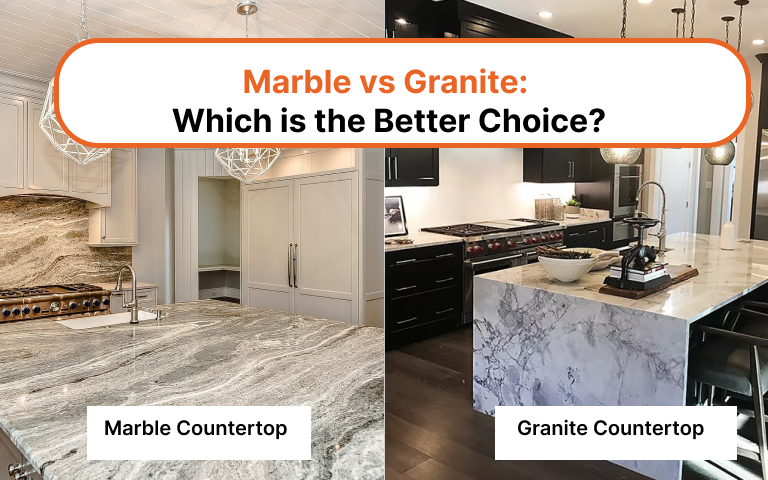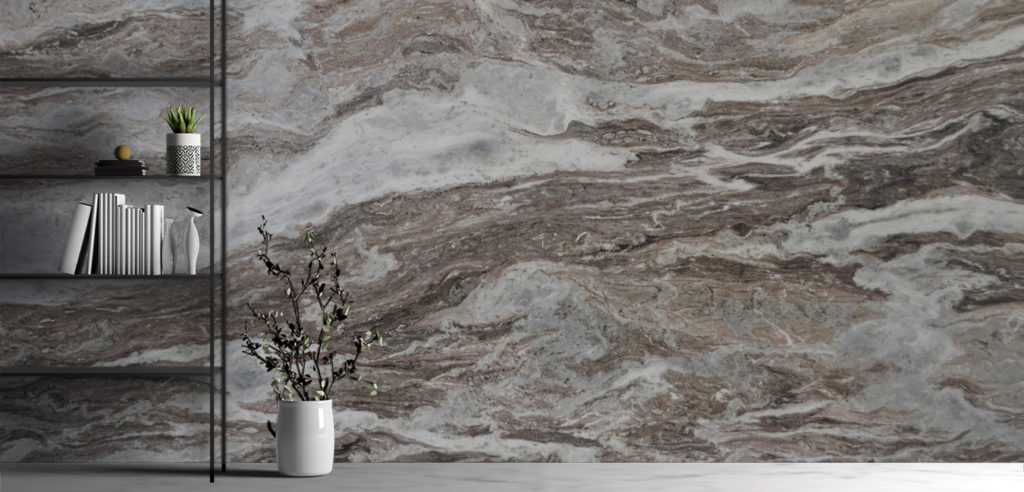When it comes to choosing the right material for the renovation of your lovely home or workplace, especially in the case of countertops, flooring, and other purposes, natural stone often tops the list. We have two of the most popular natural stones: Marble and Granite. These two stones are remarkably perfect to enhance any type of home décor with a wide range of colors, and countless customizations in terms of shape and size.
While marble offers an elegant appearance with different veining patterns, granite offers unparalleled durability with less maintenance. Therefore, deciding between the two can be a challenge. Both options have their own pros and cons, so it’s just a matter of deciding what better suits your home décor as per your needs and budget. Let’s take a deep dive through this blog to learn the common characteristics and differences, helping you make the right decision for your upcoming project.
What type of stone is Marble and Granite?
Marble and Granite are natural stones quarried from the earth’s crust. These stones undergo various processes, are cut into desired shapes, and are further distributed worldwide by wholesalers and retailers.
Marble and granite are natural stones that have gained huge popularity over the last decade. Architects, designers, and homeowners are interested in knowing the differences in terms of their formation, durability, appearance, cost, and maintenance techniques. They want to know which one is better for kitchen countertops and bathroom vanity tops. Although marble and granite slabs share similarities but have a few differences as well.
Difference between Marble and Granite
Origin of Marble & Granite
Marble is classified as a metamorphic stone because it is metamorphosed into marble from sedimentary rocks. It happens under intense heat and pressure over a long period. Some other minerals also get composed in between the process, resulting in various color variations and veining patterns. It mainly consists of a very soft component, calcium carbonate, which is responsible for the soft and sensitive nature of the marble slab stone.
Granite is classified as an Igneous rock because it originates from the earth’s crust by the cooling of a component named, “Magma”. It’s a geological process that takes millions of years, for heating, solidification, and then slowly cooling down of the magma. Due to this long and time-consuming process, granite forms the strongest and hardest natural stone. It mainly consists of feldspar, quartz, and other minerals, their composition is responsible for the color and patterns of the granite stone.
Appearance
Marble and Granite appear very similar to each other, except for the natural color variations. Marble color variations look like long, thin strips of colorful veins throughout the stone. Typically, available in variations of black and white.
Granite stone has light-to-dark color variations in the form of flecks, veins, or solid patterns. It has a packed granular surface with multiple colors and patterns depending on the composition.
Durability
The strength and durability of natural stone is always higher in comparison to engineered stones. Natural stone’s strength and durability depend on its formation process. Marble, having a maximum composition of calcium carbonate, is very soft and sensitive and has a hardness of 3 to 5 on the Mohs scale. Being soft and porous, it is susceptible to heat, stains, and scratches, making it a suitable choice for low-traffic spots such as bathroom vanities and decorative accents.


Granite is extremely durable as it is the hardest natural stone and has a ranking of 6 to 7 on the Mohs scale. It is resistant to weathering, heat, chips, and scratches, making it an ideal choice for outdoor spaces and kitchen countertops.
Applications
Marble is mostly applicable to areas that are not exposed to heat, weathering, cutting, or heavy traffic. It is mostly used for bathroom countertops, decorative accents, and flooring (in low-foot traffic areas).
Granite being strong and sturdy, can withstand almost anything in terms of weathering, heat, chips, and cracks. It is mostly applicable for kitchen countertops and flooring (for heavy foot traffic).
Maintenance
Marble and Granite, both require certain maintenance as per their durability and resistance ability. Marble, being porous and sensitive, demands more maintenance as compared to granite. The porosity of the marble makes the surface more prone to staining in case any liquid or food (wine, juice, vinegar) spills on the surface. It requires regular cleaning with a mild soap and water to keep the surface clean and beautiful. To prevent it from certain damages, seal the surface with a good quality sealant.
Granite is easy to maintain due to its extreme durability and hardness. It can resist all types of stains from foods to liquids. A good sealant once a year or thrice a year, depending upon the quality of the sealant, can prevent it from further damage.
Installation of Marble and Granite
Granite and marble slabs are installed in the same way by a professional. The template is first transferred to a slab and then further cut to give a fit and finishing. The slab is then directly placed onto cabinets and secured with a silicon adhesive. The installation charges are also similar for both marble and granite, they may vary depending on the complexity of the size and shape of the slab.
Marble Vs. Granite: Which is better for Flooring?
The choice between marble and granite for flooring depends on several factors such as the foot traffic of the area, the aesthetics, and also the cost factor. Both granite and marble have their own pros and cons when it comes to flooring.


If you want to have flooring for areas having heavy foot traffic, you should choose granite flooring. Granite is extremely durable and highly resistant to weathering, chips, and cracks. Due to its resistance qualities, it is also suitable for outdoor flooring. It barely needs any specific maintenance, making it ideal for busy places. Another benefit of granite flooring is that you can choose from a wide variety of colors, designs, and patterns.
And, if you need luxurious aesthetics and elegant appeal, you should go for marble flooring. The unique veining patterns with a wide range of colors and patterns complement the décor of your house. It also has a cooling sense of touch, making it an ideal choice for areas with high temperatures.
Marble Vs. Granite: Which is better for Countertops?
When choosing the countertops for your kitchen and bathroom, certain factors need to be kept in mind such as durability, maintenance, and appearance. All these factors help you decide the right material for your kitchen and bathroom countertops.
Granite Countertops: Granite is generally the most preferred choice for kitchen countertops due to its resistance to heat, scratches, and stains. It is most suitable for a busy kitchen environment which is more exposed to heat and staining. It demands minimal maintenance, offering a perfect balance of beauty and practicality.


Marble Countertops: Marble countertops might be the better option for bathroom purposes. It provides luxurious and aesthetic appeal, giving a stunning and high-end look. If you are someone who keeps visual appeal as a priority and can afford careful maintenance, then marble countertops are the right choice for you.
Marble Vs. Granite: Which is more expensive?
When it comes to the cost of granite and marble, factors like the type of stone, its color, veining patterns, sourcing, maintenance, and installation complexity come into consideration. The color, veining patterns, and installation costs may vary depending on the type of stone.
Marble is more expensive in comparison to granite because it demands both initial costs and ongoing maintenance. But it is worth the price if you want a luxurious and high-end look. Whereas Granite is budget-friendly and is considered an economical choice. There is no maintenance expense in the case of granite, making it an affordable choice for years.
Pros and Cons of Marble & Granite Countertops:
| Granite Pros | Granite Cons | Marble Pros | Marble Cons |
| Granite is a highly durable stone, resistant to weathering, heat, staining, chips, and cracks. Very durable, Less maintenance, Heat-resistant | The composition of the granite slab varies as per the mineral proportion during the formation. It is also responsible for variations in color and textures. | Marble is a natural stone that is popular for its aesthetic beauty and elegance. | Marble is porous and can easily get stains, from acids and food items like juices and ketchup. |
| You can choose from a variety of colors and styles available in the market. | Susceptible to heat, can get affected by thermal shock if exposed to heat. | Each slab of marble is unique with different veining patterns, colors, and styles. | Being soft and smooth in texture, it is not suitable for kitchen countertops. It can get knife scratches, chips, and cracks. |
| Being sturdy and strong, it requires very low maintenance post-installation. It is also cost-friendly as compared to other natural stones. | More detailing’s and personalized carvings are not possible in granite stone. | Personalized detailing and carvings can be done in marble slabs. | It requires proper maintenance and regular sealing, at least twice a year to prevent it from staining and scratching. |
Where can I purchase Natural Marble and Granite Countertops Slabs?
If you are planning to invest in natural stone countertops, you can get your hands on Stone Depot USA. We are a natural stone slabs supplier and distributor in Texas, USA. With a legacy of more than a decade, we deliver the finest quality stones to your doorstep. We offer a wide variety of choices in black granite, fantasy brown marble, and calacatta quartz stones at unbeatable prices.
You can reach us through our website and contact our sales support team to help you make the right choice for your project.

George is an accomplished content writer at Stone Depot, specializing in creating captivating and informative content related to the world of natural stone. With a passion for writing and a deep appreciation for the beauty and versatility of stone, he strives to provide readers with valuable insights and inspiration.



